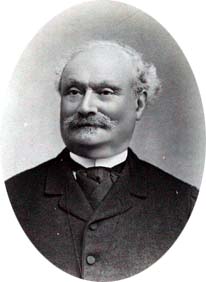Igino Cocchi
Igino Cocchi (1827- 1913)

1827
He was born in Aulla in the Province of Massa Carrara.
1852
He graduated in Pisa. In this period the University of Pisa is one of the few vital centres for paleontological and geological studies in Italy.
His great passion for Natural Sciences distinguished him among the students of P. Savi.
His primary interests are Geology and Paleontology, which fostered his friendship with Giuseppe Meneghini, the supervisor of his thesis.
about 1852-55
He travelled for long study periods to Paris and London. He visited the Société Géologique de France and got in contact with the Geological Society and the School of Mines of London which strengthened his belief that only a strong institutional basis could guarantee the revival of geological studies in Italy. He strongly felt the need for a Geological Map of Italy, following the foreign model.
1860
He was appointed Professor of Geology at the Istituto di Studi Superiori di Perfezionamento and curator of the Paleontological Collection of the Museo di Fisica e Storia Naturale of Florence.
He started working with Felice Giordano on the realization of the Geological Map of Italy.
1861-62
In view of the International Exhibition of London (1862), the Ministry of Agriculture, Industry and Trade issued a decree on 28 July 1861 for the establishment of an advisory committee for the preparation of the Geological Map of Italy.
1866
On the occasion of the International Exhibition of Paris, the Ministry of Agriculture established a geological section of the Council of Mines. Cocchi was elected Chairman with the duty of directing preparations for the Geological Map of Italy. Despite the restricted time, he managed to present simplified maps of central and northern Italy since there was a total lack of documentation and mapping data for the southern part of Italy and the islands.
1867-73
He became the Chairman of the Geological Committee of Italy, which under his leadership engaged a Secretary (in 1869), started publishing an annual Bulletin (in 1870) and established a cartographical archive and library (in 1873).
Despite the close collaboration, friction continued with his Piedmontese colleagues (Giordano and Sella). They basically belonged to two different schools. Elie de Beaumont and Leopold von Buch were a reference in Turin while in Pisa, a different school in Italy and Europe was represented by Costant Prévost and Charles Lyell.
1868
He was President and founding member of the Florence section of the Alpine Club of Italy.
He was the Correspondent of the R. Accademia dei Lincei.
from 1873
He withdrew from the chairmanship of the Geological Committee and from teaching, since he was convinced that it was impossible to realize a public scientific institute in Italy that could be compared to the Central European ones.
He became the Director of the Marble Society of Arni, which was established to improve the exploitation of the Apuan Alp marbles with scientific contributions.
1881
He was, however, still involved in Italian Geological activities and to the Italian Geological Society that was inaugurated on this date.
1887-95
He became the President of the Italian Geological Society.
1902
International Geological Congress in S. Petersburg. He travelled to Finland.
1909
He published the first Italian translation of the Finnish epic poem Kalevala.
In the final years of his life he retired in his farm in the Province of Arezzo, dedicating himself to experimental agriculture.
1913
He died in Livorno.
He was awarded several honorary titles including one as Commendatore della Corona d’Italia.
He published many essays and monographs, his geological and paleontological researches and his committment towards the increase of scientific research are an important reference in the development of natural sciences in Italy in the second half of the 19th century.
